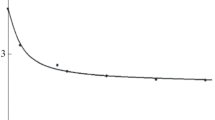Abstract
The reaction of the Cr(xx)2(H2O)2 − (xx = oxalate, malonate and methylmalonate) complexes with dissolved CO2 was studied by stopped-flow spectrophotometry in the 7 < pH < 9 range and between 20 to 30°C at an ionic strength of 0.5 mol dm−3 (NaCl). Under the experimental conditions the aqua complex ion consists of a pH-dependent mixture of Cr(xx)2(H2O)2 −, Cr(xx)2(OH) (H2O)2− and Cr(xx)2(OH)2 3−. The monohydroxo and dihydroxo species undergo CO2 uptake and subsequent intramolecular carbonate ligand chelation independently, at rates which are readily distinguishable and are governed by the uptake rate constants k 1 and k 2 and chelation rate constants k 3 and k 4, respectively. Only the k 1 values for oxalato, malonato and methylmalonato complexes could be calculated; k 1 = 1084 and 1333 and 1650 mol−1 dm3 s−1, respectively. The results obtained were compared with those obtained from other systems that have either cobalt(III), iridium(III) or rhodium(III) as central atoms.
Similar content being viewed by others
References
E. Chaffee, T. P. Dasgupta and G. M. Harris, J. Am. Chem. Soc., 95, 4169 (1973).
D. A. Palmer and G. M. Harris, Inorg. Chem., 13, 965 (1974).
T. P. Dasgupta and G. M. Harris, J. Am. Chem. Soc., 97, 1733 (1975).
T. P. Dasgupta and G. M. Harris, J. Am Chem. Soc., 99, 2490 (1977).
D. J. Francis and R. B. Jordon, J. Am. Chem. Soc., 91, 6626 (1969).
D. A. Palmer, T. P. Dasgupta and H. Kim, Inorg. Chem., 17, 1173 (1978).
J. M. Dejovine, W. K. Wan and G. M. Harris, unpublished observations, Ref. 6.
W. G. Palmer, Experimental Inorganic Chemistry, Cambridge University Press, Cambridge, 1954, p. 389.
J. C. Change, J. Inorg. Nucl. Chem., 29, 2387 (1967).
J. C. Chang, J. Inorg. Nucl. Chem., 34, 221 (1972).
V. Subbiah, M. W. Pandit, C. S. T. Sai and N. R. Anipindi, Bull. Chem. Soc. Jpn., 63, 3644 (1990).
M. Casula, G. Illuminate and G. Ortaggi, Inorg. Chem., 11, 1062 (1972).
R. E. Hamm, R. L. Johnson, R. H. Perkins and R. E. Davis, J. Am. Chem. Soc., 80, 4469 (1958).
Author information
Authors and Affiliations
Rights and permissions
About this article
Cite this article
Sai, C.S., Hela, P.G., Sridhar, Y. et al. Kinetic and mechanistic studies on the formation of bis(dicarboxylato)carbonatochromate(III) complexes. Transition Metal Chemistry 23, 249–252 (1998). https://doi.org/10.1023/A:1015788211974
Issue Date:
DOI: https://doi.org/10.1023/A:1015788211974




